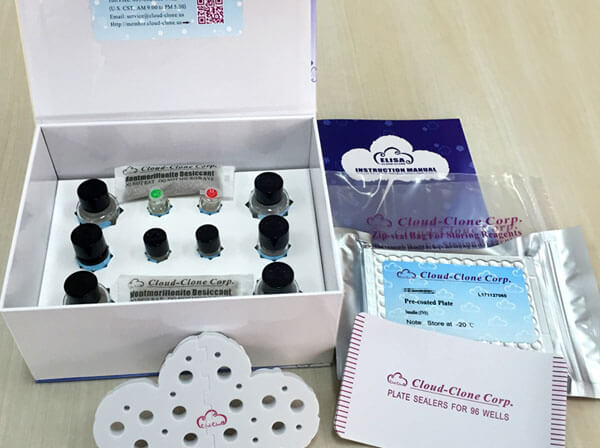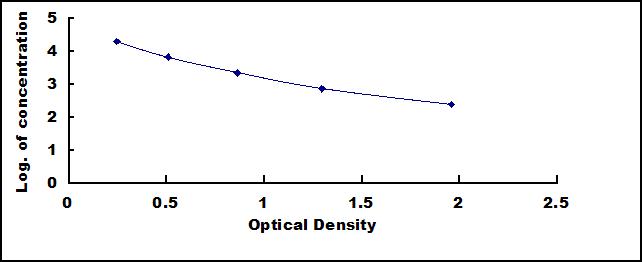ELISA Kit for Myelin Basic Protein (MBP) 

Myelin A1 protein; Myelin membrane encephalitogenic protein
- UOM
- FOB US$ 441.00 US$ 630.00 US$ 2,835.00 US$ 5,355.00 US$ 44,100.00
- Quantity
Overview
Properties
- Product No.CEA539Hu
- Organism SpeciesHomo sapiens (Human) Same name, Different species.
- ApplicationsEnzyme-linked immunosorbent assay for Antigen Detection.
Research use only - DownloadInstruction Manual
- CategoryInfection immunityNeuro scienceAutoimmunity
Sign into your account
Share a new citation as an author
Upload your experimental result
Review

Contact us
Please fill in the blank.
Recovery
Matrices listed below were spiked with certain level of recombinant Myelin Basic Protein (MBP) and the recovery rates were calculated by comparing the measured value to the expected amount of Myelin Basic Protein (MBP) in samples.
| Matrix | Recovery range (%) | Average(%) |
| serum(n=5) | 98-105 | 102 |
| EDTA plasma(n=5) | 92-101 | 96 |
| heparin plasma(n=5) | 86-103 | 92 |
Precision
Intra-assay Precision (Precision within an assay): 3 samples with low, middle and high level Myelin Basic Protein (MBP) were tested 20 times on one plate, respectively.
Inter-assay Precision (Precision between assays): 3 samples with low, middle and high level Myelin Basic Protein (MBP) were tested on 3 different plates, 8 replicates in each plate.
CV(%) = SD/meanX100
Intra-Assay: CV<10%
Inter-Assay: CV<12%
Linearity
The linearity of the kit was assayed by testing samples spiked with appropriate concentration of Myelin Basic Protein (MBP) and their serial dilutions. The results were demonstrated by the percentage of calculated concentration to the expected.
| Sample | 1:2 | 1:4 | 1:8 | 1:16 |
| serum(n=5) | 79-90% | 90-99% | 93-105% | 88-95% |
| EDTA plasma(n=5) | 80-103% | 97-104% | 94-105% | 94-103% |
| heparin plasma(n=5) | 97-105% | 79-91% | 88-96% | 87-95% |
Stability
The stability of kit is determined by the loss rate of activity. The loss rate of this kit is less than 5% within the expiration date under appropriate storage condition.
To minimize extra influence on the performance, operation procedures and lab conditions, especially room temperature, air humidity, incubator temperature should be strictly controlled. It is also strongly suggested that the whole assay is performed by the same operator from the beginning to the end.
Reagents and materials provided
| Reagents | Quantity | Reagents | Quantity |
| Pre-coated, ready to use 96-well strip plate | 1 | Plate sealer for 96 wells | 4 |
| Standard | 2 | Standard Diluent | 1×20mL |
| Detection Reagent A | 1 | Assay Diluent A | 1×12mL |
| Detection Reagent B | 1×120µL | Assay Diluent B | 1×12mL |
| Reagent Diluent | 1×300µL | Stop Solution | 1×6mL |
| TMB Substrate | 1×9mL | Instruction manual | 1 |
| Wash Buffer (30 × concentrate) | 1×20mL |
Assay procedure summary
1. Prepare all reagents, samples and standards;
2. Add 50µL standard or sample to each well.
And then add 50µL prepared Detection Reagent A immediately.
Shake and mix. Incubate 1 hour at 37°C;
3. Aspirate and wash 3 times;
4. Add 100µL prepared Detection Reagent B. Incubate 30 minutes at 37°C;
5. Aspirate and wash 5 times;
6. Add 90µL Substrate Solution. Incubate 10-20 minutes at 37°C;
7. Add 50µL Stop Solution. Read at 450 nm immediately.

Test principle
This assay employs the competitive inhibition enzyme immunoassay technique. A monoclonal antibody specific to Myelin Basic Protein (MBP) has been pre-coated onto a microplate. A competitive inhibition reaction is launched between biotin labeled Myelin Basic Protein (MBP) and unlabeled Myelin Basic Protein (MBP) (Standards or samples) with the pre-coated antibody specific to Myelin Basic Protein (MBP). After incubation the unbound conjugate is washed off. Next, avidin conjugated to Horseradish Peroxidase (HRP) is added to each microplate well and incubated. The amount of bound HRP conjugate is reverse proportional to the concentration of Myelin Basic Protein (MBP) in the sample. After addition of the substrate solution, the intensity of color developed is reverse proportional to the concentration of Myelin Basic Protein (MBP) in the sample.
Giveaways
Increment services
Citations
- CD98 Positive Eosinophils Contribute to T Helper 1 Pattern InflammationPlosOne: Source
- Effects of Exposure to 1-Bromopropane on Astrocytes and Oligodendrocytes in Rat BrainPubmed: 23183024
- Myelin basic protein and ischemia modified albumin levels in acute ischemic stroke casesPubMed: 26648996
- Morphology and staining behavior of neutrophilic and eosinophilic granulocytes of the common marmoset (Callithrix jacchus)Pubmed:27165445
- Serum microtubule associated protein tau and myelin basic protein as the potential markers of brain ischaemia-reperfusion injury in patients undergoing carotid endarterectomyAA.2016.0008
- Myelin Basic Protein Regulates Primitive and Definitive Neural Stem Cell Proliferation from the Adult Spinal Cord.pubmed:27573615
- Glial markers and emotional memory in rats following acute cerebral radiofrequency exposures.pubmed:27696165
- Serum microtubule associated protein tau and myelin basic protein as the potential markers of brain ischaemia-reperfusion injury in patients undergoing carotid endarterectomyAA.2016.0008
- Functional and phenotypic evaluation of eosinophils from patients with the acute form of paracoccidioidomycosispubmed:28489854
- Acrolein-mediated neurotoxicity in growing Wistar male ratsPubmed:30033014
- Association and Risk of Canine Distemper with Respect to Age, Sex and Breed of Dogs Suffering from Demyelinating Neuropathies10.5455:ijlr.20170811080455
- Biosensors and nanobiosensors for rapid detection of autoimmune diseases: a reviewPubmed: 31760523
- The role of light desynchronosis in the development of stress-induced aging
- Association of eosinophil-mediated inflammatory biomarkers with the presence of the Schatzki ring34091432
- Searching for Noninvasive Predictors of the Diagnosis and Monitoring of Eosinophilic Esophagitis¡ªThe Importance of Biomarkers of the Inflammatory Reaction?¡
- Monitoring autoimmune diseases by bioelectrochemical detection of autoantibodies. Application to the determination of anti-myelin basic protein autoantibodies in …Pubmed:35202838

















